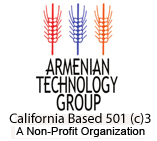Arjoot -- ATG Helps Bring Hope to Mountain Village
| August 5, 2003
Arjoot, Province of Lori, Armenia — From his mountain village in northern Armenia, Vardan Mkrtchyan takes pride in the thriving agricultural economy he helped build. Mkrtchyan moved his young family to the village of Arjoot in 1989, a time when the Soviet Union was beginning to unravel. Mkrtchyan was attracted to Arjoot because of the village’s abundant sunshine and rich farmland. When he arrived, however, Arjoot’s economy was in tatters. The 1988 earthquake that devastated much of northern Armenia left Arjoot battered and isolated. Moreover, the conflict between Armenians and Azerbaijanis over Nagorno Karabakh created further turmoil. Nonetheless, when Mkrtchyan came to the highland region of Lori, he saw a bright future for himself and his family. “I love farming,” Mkrtchyan said, “and I wanted to do my part to rebuild Armenia after the earthquake. When I saw Arjoot, I knew I had found home.” Arjoot is nestled along the gorge of the Arpa River in a heavily forested area of the Bazum mountain range. Farms dot the hillsides and spread out on the expansive plains above the gorge. “When I first arrived in Arjoot, I farmed pears, apples, and strawberries,” Mkrtchyan said. “But there was very little wheat or barley being grown. The open fields where wheat had been grown were lying fallow. There was no bread in our village.” After the collapse of the Soviet Union, Arjoot farmers lost access to fresh wheat seed. Instead, they planted low-quality local or Russian varieties of wheat. Yields plummeted, and villagers had little hope for the future. That’s when Mkrtchyan discovered the Armenian Technology Group (ATG), a California-based non-profit organization dedicated to the advancement of Armenia’s agriculture. Reading an article in Agro Tert, a newspaper specializing in agricultural news in Armenia, Mkrtchyan learned that ATG was experimenting with new varieties of wheat in trial plots throughout Armenia. “The next day,” Mkrtchyan said, “I contacted ATG area agronomists Vannik Simonyan and Vazken Ohanyan. They both told me about the successes farmers were having with the new American varieties.” Mkrtchyan was accepted as a participant in the seed multiplication program, in which farmers are given seed and fertilizer and repay ATG after selling their crop. ATG supplied Mkrtchyan with seed for five hectares (12.35 acres) of Weston, one of the new varieties of red wheat that had proven successful in the province of Lori. After his harvest, Mkrtchyan was sold on the program. “The wheat looked great,” Mkrtchyan said. “Besides having a good yield, I was impressed with the high quality of seed. I was able to repay ATG and sell the remaining seed to other farmers. Everything I had heard from ATG’s experts was true.” That year, he told his three brothers, who were still living near Aparan, to come to Arjoot. “I knew we had a future in Arjoot,” he said. Rebuilding with Hope The highest peaks of the Bazum mountains overlook Arjoot. The Arpi River divides the village into two parts. The bridge linking the two sections of the village was destroyed in the 1988 earthquake, making it difficult for farmers to move tractors and other farm equipment from plot to plot. When Mkrtchyan’s brothers arrived in Arjoot, they rebuilt the bridge with their own hands. Today, Mkrtchyan grows alfalfa about 300 yards above the bridge, on a large, flat area overlooking the town of Spitak. The alfalfa seed comes from ATG’s warehouse in Akhourian, in the neighboring province of Shirak. “The seed was excellent,” Mkrtchyan said. “I was impressed with ATG’s facilities, and how the staff had carefully cleaned and treated the seed before selling it.” Mkrtchyan’s first alfalfa crop was hurt by drought. The second year, however, produced stunning results. Mkrtchyan cut his fields three times and achieved a yield of almost 9.5 metric tons per hectare (3.85 metric tons per acre). Toward a Brighter Future Mkrtchyan’s success in wheat and alfalfa farming has enable him to expand his farming operations. Last year he planted barley for the first time, on a 27-hectare (66.7-acre) plot adjacent to his alfalfa field. “ATG agronomists suggested the ’10-20′ variety of barley, which they had experimented with in Spitak, and had good results,” Mkrtchyan said, adding, “I appreciate ATG’s knowledge and professionalism.” Mkrtchyan’s success has also helped other farmers, who are now growing the Weston variety and are purchasing the seed from Mkrtchyan. “I want the entire village to prosper, and with ATG’s assistance, this is happening,” he says. In Armenia, bread and the cultivation of wheat are held in such esteem that if someone sees a piece of bread in the street, he picks it up and places it in a high location, so birds and other animals can eat it. Now, Armenian farmers in Arjoot are growing their beloved wheat with seed furnished by ATG. “ATG gave us seed and fertilizer when we had none,” Mkrtchyan said. “We will always remember what ATG did for our farmers.” An ancient khachkar (stone cross) was recently discovered in Arjoot, inspiring the residents to give the village an Armenian name. “We are considering Arevik (little sun),” Mkrtchyan said, “because of the bright sun here, and because Arjoot is now an Armenian village, with hope for the future.” For more information about how you can help Armenia’s farmers, contact the ATG office at (559) 224-1000 or by e-mail (info@atgusa.org). Tax-deductible donations can be sent to ATG; 1300 E. Shaw, Suite 149; P.O.Box 5969; Fresno, CA 93755-5969. |

Follow Us